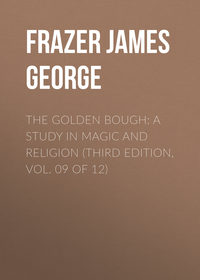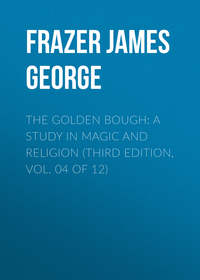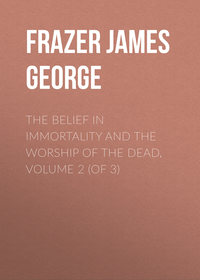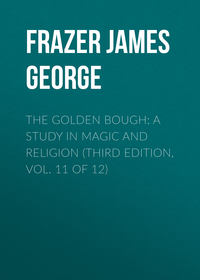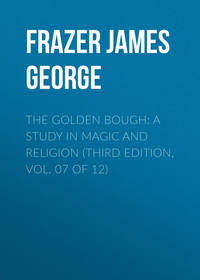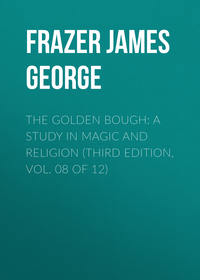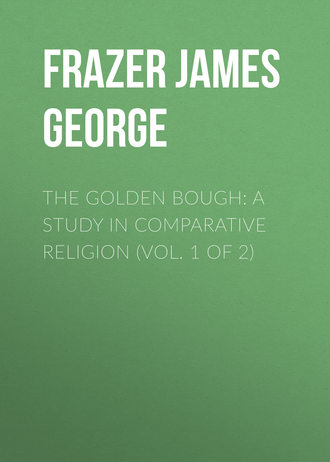
The Golden Bough: A Study in Comparative Religion (Vol. 1 of 2)
682
Valerius Flaccus, Argonaut, i. 378 sq.: —
“Tectus et Eurytion servato colla capillo,Quem pater Aonias reducem tondebit ad aras.”
683
Homer, Iliad, xxiii. 141 sqq.
684
D. Porter, Journal of a Cruise made to the Pacific Ocean, ii. 120.
685
Paulus Diaconus, Hist. Langobard. iii. 7.
686
Ellis, Polynesian Researches, iv. 387.
687
Numbers vi. 5.
688
J. A. E. Köhler, Volksbrauch, etc. im Voigtlande, p. 424; W. Henderson, Folk-lore of the Northern Counties, p. 16 sq.; F. Panzer, Beitrag zur deutschen Mythologie, i. 258; Zingerle, Sitten, Bräuche und Meinungen des Tiroler Volkes,2 Nos. 46, 72; J. W. Wolf, Beitrage zur deutschen Mythologie, i. 208 (No. 45), 209 (No. 53); Knoop, Volkssagen, Erzählungen, etc. aus dem östlichen Hinterpommern, p. 157 (No. 23); E. Veckenstedt, Wendische Sagen, Märchen und abergläubische Gebräuche, p. 445; J. Haltrieh, Zur Volkskunde der Siebenbürger Sachsen, p. 313; E. Krause, “Abergläubische Kuren u. sonstiger Aberglaube in Berlin,” Zeitschrift für Ethnologie, xv. 84.
689
Panjab Notes and Queries, ii. No. 1092.
690
G. Gibbs, “Notes on the Tinneh or Chepewyan Indians of British and Russian America,” in Annual Report of the Smithsonian Institution, 1866, p. 305; W. Dall, Alaska and its Resources, p. 202. The reason alleged by the Indians (that if the girls' nails were cut sooner the girls would be lazy and unable to embroider in porcupine quill-work) is probably a late invention, like the reasons assigned in Europe for the similar custom (the commonest being that the child would become a thief).
691
Knoop, l. c.
692
Wolf, Beiträge zur deutschen Mythologie, i. 209 (No. 57).
693
R. Taylor, New Zealand and its Inhabitants, p. 206 sqq.
694
Richard A. Cruise, Journal of a Ten Months' Residence in New Zealand, p. 283 sq. Cp. Dumont D'Urville, Voyage autour du Monde et à la recherche de La Pérouse. Histoire du Voyage (Paris, 1832), ii. 533.
695
E. Shortland, Traditions and Superstitions of the New Zealanders, p. 108 sqq.; Taylor, l. c.
696
J. Moura, Le Royaume du Cambodge, i. 226 sq.
697
See above, p. 111.
698
Brough Smyth, Aborigines of Victoria, i. 468 sq.
699
D. Porter, Journal of a Cruise made to the Pacific Ocean, ii. 188.
700
J. Dawson, Australian Aborigines, p. 36.
701
A. W. Howitt, “On Australian Medicine-men,” in Journ. Anthrop. Inst. xvi. 27. Cp. E. Palmer, “Notes on some Australian Tribes,” in Journ. Anthrop. Inst. xiii. 293; James Bonwick, Daily Life of the Tasmanians, p. 178; James Chalmers, Pioneering in New Guinea, p. 187; J. S. Polack, Manners and Customs of the New Zealanders, i. 282; Bastian, Die Völker des östlichen Asien, iii. 270; Langsdorff, Reise um die Welt, i. 134 sq. A. S. Thomson, The Story of New Zealand, i. 79, 116 sq.; Ellis, Polynesian Researches, i. 364; Zingerle, Sitten, Bräuche und Meinungen des Tiroler Volkes,2 No. 178.
702
Meier, Deutsche Sagen, Sitten und Gebräuche aus Schwaben, p. 509; Panzer, Beitrag zur deutschen Mythologie, i. 258; J. A. E. Köhler, Volksbrauch etc. im Voigtlande, p. 425; A. Witzschel, Sagen, Sitten und Gebräuche aus Thüringen, p. 282; Zingerle, op. cit. No. 180; Wolf, Beiträge zur deutschen Mythologie, i. 224 (No. 273).
703
Zingerle, op. cit. No. 181.
704
Zingerle, op. cit. Nos. 176, 179.
705
A. Krause, Die Tlinkit-Indianer. (Jena, 1885), p. 300.
706
Petronius, Sat. 104.
707
Bastian, Die deutsche Expedition an der Loango-Küste, i. 231 sq.; id., Ein Besuch in San Salvador, p. 117.
708
W. Stanbridge, “On the Aborigines of Victoria,” in Transact. Ethnolog. Soc. of London, i. 300.
709
François Pyrard, Voyages to the East Indies, the Maldives, the Moluccas, and Brazil. Translated by Albert Gray (Hakluyt Society, 1887), i. 110 sq.
710
Shortland, Traditions and Superstitions of the New Zealanders, p. 110.
711
Polack, Manners and Customs of the New Zealanders, i. 38 sq.
712
James Wilson, A Missionary Voyage to the Southern Pacific Ocean, p. 355.
713
Aulus Gellius, x. 15, 15.
714
Pliny, Nat. Hist. xvi. 235; Festus, s. v. capillatam vel capillarem arborem.
715
Wuttke, Der deutsche Volksaberglaube,2 § 464.
716
W. Mannhardt, Germanische Mythen, p. 630.
717
W. Henderson, Folk-lore of the Northern Counties, p. 17.
718
Riedel, De sluik-en kroesharige rassen tusschen Selebes en Papua, p. 74.
719
Riedel, op. cit. p. 265.
720
G. Heijmering “Zeden en gewoonten op het eiland Rottie,” in Tijdschrift voor Neêrland's Indie (1843), dl. ii. 634-637.
721
W. Dall, Alaska and its Resources, p. 54; F. Whymper, “The Natives of the Youkon River,” in Transact. Ethnolog. Soc. of London, vii. 174.
722
E. Meier, Deutsche Sagen, Sitten und Gebräuche aus Schwaben, p. 509.
723
W. Mannhardt, Germanische Mythen, p. 630.
724
H. B. Guppy, The Solomon Islands and their Natives, p. 54.
725
Fargaard, xvii.
726
Grihya-Sûtras, translated by H. Oldenberg (Oxford, 1886), vol. i. p. 57.
727
R. W. Felkin, “Notes on the Madi or Moru tribe of Central Africa,” in Proceedings of the Royal Society of Edinburgh, xii. (1882-84) p. 332.
728
A. Steedman, Wanderings and Adventures in the Interior of Southern Africa (London, 1835), i. 266.
729
Emin Pasha in Central Africa, being a Collection of his Letters and Journals (London, 1888), p. 74.
730
J. L. Wilson, West Afrika, p. 159 (German trans.)
731
N. P. Wilken en J. A. Schwarz, “Allerlei over het land en volk van Bolaang Mongondou,” in Mededeelingen van wege het Nederlandsche Zendelinggenootschap, xi. (1867) p. 322.
732
Garcilasso de la Vega, First part of the Royal Commentaries of the Yncas, bk. ii. ch. 7 (vol. i. p. 127, Markham's translation).
733
Mélusine, 1878, c. 583 sq.
734
The People of Turkey, by a Consul's daughter and wife, ii. 250.
735
Boecler-Kreutzwald, Der Ehsten abergläubische Gebräuche, Weisen und Gewohnheiten, p. 139; F. J. Wiedemann, Aus dem innern und äussern Leben der Ehsten, p. 491.
736
R. W. Felkin, “Notes on the For tribe of Central Africa,” in Proceedings of the Royal Society of Edinburgh, xiii. (1884-86) p. 230.
737
Zingerle, Sitten, Bräuche und Meinungen des Tiroler Volkes,2 Nos. 176, 580; Mélusine, 1878, c. 79.
738
Musters, “On the Races of Patagonia,” in Journ. Anthrop. Inst. i. 197; J. Dawson, Australian Aborigines, p. 36.
739
David Livingstone, Narrative of Expedition to the Zambesi, p. 46 sq.
740
Zingerle, op. cit. Nos. 177, 179, 180.
741
M. Jahn, Hexenwesen und Zauberei in Pommern, p. 15; Mélusine, 1878, c. 79.
742
E. H. Meyer, Indogermanische Mythen, ii. Achilleis (Berlin, 1887), p. 523.
743
Above, p. 201.
744
Above, pp. 167, 169 sqq.
745
W. Ridley, “Report on Australian Languages and Traditions,” in Journ. Anthrop. Inst. ii. 268.
746
See G. A. Wilken, Ueber das Haaropfer und einige andere Trauergebräuche bei den Völkern Indonesiens, p. 94 sqq.; H. Ploss, Das Kind in Branch und Sitte der Völker2 i. 289 sqq.
747
Above, p. 194.
748
Above, p. 157 sq.
749
Monier Williams, Religious Thought and Life in India, p. 375.
750
Above, p. 117.
751
Bastian, Die deutsche Expedition an der Loango-Küste, ii. 170. The blood may be drunk by them as a medium of inspiration. See above, p. 34 sq.
See above, p. 16.
752
Dapper, Description de l'Afrique, p. 336.
753
T. J. Hutchinson, Impressions of Western Africa (London, 1858), p. 198.
754
G. Watt (quoting Col. W. J. M'Culloch), “The Aboriginal Tribes of Manipur,” in Journ. Anthrop. Inst. xvi. 360.
755
Meiners, Geschichte der Religionen, i. 48.
756
R. I. Dodge, Our Wild Indians, p. 112.
757
Blumentritt, “Der Ahnencultus und die relig. Anschauungen der Malaien des Philippinen-Archipels,” in Mittheilungen d. Wiener Geogr. Gesellschaft, 1882, p. 198.
758
Theophilus Hahn, Tsuni-Goam, the Supreme Being of the Khoi-Khoi, pp. 56, 69.
759
Diodorus, iii. 61; Pomponius Mela, ii. 7, 112; Minucius Felix, Octavius, 21.
760
Plutarch, Isis et Osiris, 35; Philochorus, Fragm. 22, in Müller's Fragm. Hist. Graec. i. p. 387.
761
Porphyry, Vit. Pythag. 16.
762
Philochorus, Fr. 184, in Fragm. Hist. Graec. ii. p. 414.
763
Lobeck, Aglaophamus, p. 574 sq.
764
See above, p. 121 sqq.
765
Gill, Myths and Songs of the South Pacific, p. 163.
766
Ch. Wilkes, Narrative of the U. S. Exploring Expedition (London, 1845), iii. 96.
767
U. S. Exploring Expedition, Ethnology and Philology, by H. Hale (Philadelphia, 1846), p. 65. Cp. Th. Williams, Fiji and the Fijians, i. 183; J. E. Erskine, Journal of a Cruise among the Islands of the Western Pacific, p. 248.
768
Turner, Samoa, p. 335.
769
Martin Flad, A Short Description of the Falasha and Kamants in Abyssinia, p. 19.
770
J. B. Labat, Relation historique de l'Ethiopie Occidentale, i. 260 sq.; W. Winwood Reade, Savage Africa, p. 362.
771
Diodorus Siculus, iii. 6; Strabo, xvii. 2, 3.
772
Emin Pasha in Central Africa, being a Collection of his Letters and Journals (London, 1888), p. 91.
773
P. Guillemé, “Credenze religiose dei Negri di Kibanga nell' Alto Congo,” in Archivio per lo studio delle tradizioni popolari, vii. (1888) p. 231.
774
Nathaniel Isaacs, Travels and Adventures in Eastern Africa, i. p. 295 sq., cp. pp. 232, 290 sq.
775
Above, p. 45 sq.
776
Dos Santos, “History of Eastern Ethiopia” (published at Paris in 1684), in Pinkerton's Voyages and Travels, xvi. 684.
777
Plutarch, Agesilaus, 3.
778
Herodotus, iii. 20; Aristotle, Politics, iv. 4, 4; Athenaeus, xiii. p. 566. According to Nicolaus Damascenus (Fr. 142, in Fragm. Historic. Graecor. ed. C. Müller, iii. p. 463), the handsomest and bravest man was only raised to the throne when the king had no heirs, the heirs being the sons of his sisters. But this limitation is not mentioned by the other authorities. Among the Gordioi the fattest man was chosen king; among the Syrakoi, the tallest, or the man with the longest head. Zenobius, v. 25.
779
G. Nachtigal, Saharâ und Sûdân (Leipzig, 1889), iii. 225; Bastian, Die deutsche Expedition an der Loango-Küste, i. 220.
780
Strabo, xvii. 2, 3; Diodorus, iii. 7.
781
Mohammed Ebn-Omar El-Tounsy, Voyage au Darfour (Paris, 1845), p. 162 sq.; Travels of an Arab Merchant in Soudan, abridged from the French by Bayle St. John (London, 1854), p. 78; Bulletin de la Société de Géographie (Paris) IVme Série, iv. (1852) p. 539 sq.
782
R. W. Felkin, “Notes on the Waganda Tribe of Central Africa,” in Proceedings of the Royal Society of Edinburgh, xiii. (1884-1886) p. 711.
783
Narrative of events in Borneo and Celebes, from the Journals of James Brooke, Esq., Rajah of Sarawak. By Captain R. Mundy, i. 134.
784
Simon Grunau, Preussische Chronik, herausgegeben von Dr. M. Perlbach (Leipzig, 1876), i. p. 97.
785
Barbosa, A Description of the Coasts of East Africa and Malabar in the beginning of the Sixteenth Century (Hakluyt Society, 1866), p. 172 sq.
786
Alex. Hamilton, “A new Account of the East Indies,” in Pinkerton's Voyages and Travels, viii. 374.
787
Athenaeus, xiv. p. 639 c; Dio Chrysostom, Orat. iv. p. 69 sq. (vol. i. p. 76, ed. Dindorf). Dio Chrysostom does not mention his authority, but it was probably either Berosus or Ctesias. Though the execution of the mock king is not mentioned in the passage of Berosus cited by Athenaeus, the omission is probably due to the fact that the mention of it was not germane to Athenaeus's purpose, which was simply to give a list of festivals at which masters waited on their servants. That the ζωγάνης was put to death is further shown by Macrobius, Sat. iii. 7, 6, “Animas vero sacratorum hominum quos † zanas Graeci vocant, dis debitas aestimabant,” where for zanas we should probably read ζωγάνας with Liebrecht, in Philologus, xxii. 710, and Bachofen, Die Sage von Tanaquil, p. 52, note 16. The custom, so far as appears from our authorities, does not date from before the Persian domination in Babylon; but probably it was much older. In the passage of Dio Chrysostom ἐκρέμασαν should be translated “crucified” (or “impaled”), not “hung.” It is strange that this, the regular, sense of κρεμάννυμι, as applied to executions, should not be noticed even in the latest edition of Liddell and Scott's Greek Lexicon. Hanging, though a mode of suicide, was not a mode of execution in antiquity either in the east or west. In one of the passages cited by L. and S. for the sense “to hang” (Plutarch, Caes. 2), the context proves that the meaning is “to crucify.”
788
E. Aymonier, Notice sur le Cambodge, p. 61; J. Moura, Le Royaume du Cambodge, i. 327 sq. For the connection of the temporary king's family with the royal house, see Aymonier, op. cit. p. 36 sq.
789
Pallegoix, Description du Royaume Thai ou Siam, i. 250; Bastian, Die Völker des östlichen Asien, iii. 305-309, 526-528; Turpin, History of Siam, in Pinkerton's Voyages and Travels, ix. 581 sq. Bowring (Siam, i. 158 sq.) copies, as usual, from Pallegoix.
790
Lieut. Col. James Low, “On the Laws of Muung Thai or Siam,” in Journal of the Indian Archipelago, i. (Singapore, 1847) p. 339; Bastian, Die Völker des östlichen Asien, iii. 98, 314, 526 sq.
791
C. B. Klunzinger, Bilder aus Ober-ägypten, der Wüste und dem Rothen Meere, p. 180 sq.
792
J. W. Boers, “Oud volksgebruik in het Rijk van Jambi,” in Tijdschrift voor Neêrland's Indië, iii. (1840), dl. i. 372 sqq.
793
Panjab Notes and Queries, i. 674.
794
Aeneas Sylvius, Opera (Bâle, 1571), p. 409 sq.; Grimm, Deutsche Rechtsalterthümer, p. 253. According to Grimm (who does not refer to Aeneas Sylvius) the cow and mare stood beside the prince, not the peasant.
795
Lasicius, “De diis Samagitarum caeterorumque Sarmatarum,” in Respublica sive Status Regni Poloniae, Lituaniae, Prussiae, Livoniae, etc. (Elzevir, 1627), p. 306 sq.; id. edited by W. Mannhardt in Magazin herausgegeben von der Lettisch-Literärischen Gesellschaft, xiv. 91 sq.
796
Macrobius, Saturn. v. 19, 13.
797
See above, p. 172 sqq.
798
Philo of Byblus, quoted by Eusebius, Praepar. Evang. i. 10, 29 sq.
799
2 Kings iii. 27.
800
Porphyry, De abstin. ii. 56.
801
Diodorus, xx. 14.
802
Porphyry, De abstin. ii. 54.
803
Brough Smyth, Aborigines of Victoria, ii. 311.
804
Strachey, Historie of travaille into Virginia Britannia (Hakluyt Society), p. 84.
805
J. L. Krapf, Travels, Researches, and Missionary Labours during an Eighteen Years' Residence in Eastern Africa, p. 69 sq. Dr. Krapf, who reports the custom at second hand, thinks that the existence of the pillar may be doubted, but that the rest of the story harmonises well enough with African superstition.
806
F. J. Mone, Geschichte des Heidenthums im nördlichen Europa, i. 119.
807
Above, p. 42 sqq.
808
Nieuwenhuisen en Rosenberg, “Verslag omtrent het eiland Nias,” in Verhandelingen van het Batav. Genootschap van Kunsten en Wetenschappen, xxx. 85; Rosenberg, Der Malayische Archipel, p. 160; Chatelin, “Godsdienst en bijgeloof der Niassers,” in Tijdschrift voor Indische Taal- Land- en Volkenkunde, xxvi. 142 sq.; Sundermann, “Die Insel Nias und die Mission daselbst,” in Allgemeine Missions-Zeitschrift, xi. 445.
809
Ch. Wilkes, Narrative of the U. S. Exploring Expedition (London, 1845), iv. 453; U. S. Exploring Expedition, Ethnography and Philology, by H. Hale, p. 203.
810
D. G. Brinton, Myths of the New World, p. 270 sq.
811
Servius on Virgil, Aen. iv. 685; Cicero, In Verr. ii. 5, 45; K. F. Hermann, Griech. Privatalterthümer, ed. Blumner, p. 362 note 1.
812
Harland and Wilkinson, Lancashire Folk-lore, p. 7 sq.
813
Fr. Panzer, Beitrag zur deutschen Mythologie, i. 235 sq.; W. Mannhardt, Baumkultus, p. 320 sq.
814
E. Meier, Deutsche Sagen, Sitten und Gebräuche aus Schwaben, pp. 409-419; W. Mannhardt, Baumkultus, p. 349 sq.
815
E. Sommer, Sagen, Märchen und Gebräuche aus Sachsen und Thüringen, p. 154 sq.; W. Mannhardt, Baumkultus, p. 335 sq.
816
W. Mannhardt, Baumkultus, p. 336.
817
Reinsberg – Düringsfeld, Fest-Kalender aus Böhmen, p. 61; W. Mannhardt, Baumkultus, p. 336 sq.
818
Reinsberg-Düringsfeld, Fest-Kalender aus Böhmen, p. 263; W. Mannhardt, Baumkultus, p. 343.
819
Reinsberg-Düringsfeld, Fest-Kalender aus Böhmen, p. 269 sq.
820
See above, p. 92 sq.
821
Reinsberg-Düringsfeld, Fest-Kalender aus Böhmen, p. 264 sq.; W. Mannhardt, Baumkultus, p. 353 sq.
822
See pp. 243, 246.
823
See p. 15 sqq.
824
See p. 243.
825
Above, p. 4.
826
Marquardt, Römische Staatsverwaltung, iii.2 323 sq.
827
See above, p. 6.
828
Caesar, Bell. Gall. vi. 16; Adam of Bremen, Descript. Insul. Aquil. c. 27; Olaus Magnus, iii. 6; Grimm, Deutsche Mythologie,4 i. 35 sqq.; Mone, Geschichte des nordischen Heidenthums, i. 69, 119, 120, 149, 187 sq.
829
J. G. Bourke, Snake Dance of the Moquis of Arizona, p. 196 sq.
830
Euripides, Iphig. in Taur. 1458 sqq.
831
Nieuwenhuisen en Rosenberg, “Verslag omtrent het eiland Nias,” in Verhandelingen van het Batav. Genootsch. van Kunsten en Wetenschappen, xxx. 43.
832
J. A. Dubois, Moeurs, Institutions et Cérémonies des Peuples de l'Inde, i. 151 sq.
833
“The Rudhirádhyáyă, or sanguinary chapter,” translated from the Calica Puran by W. C. Blaquiere, in Asiatick Researches, v. 376 (8vo. ed. London, 1807).
834
Dalton, Ethnology of Bengal, p. 281.
835
Dalton, Ethnology of Bengal, p. 258 sq.
836
Grimm, Deutsche Mythologie,4 ii. 645; K. Haupt, Sagenbuch der Lausitz, ii. 58; Reinsberg-Düringsfeld, Fest-Kalender aus Böhmen, p. 86 sq.; id., Das festliche Jahr, p. 77 sq. The Fourth Sunday in Lent is also known as Mid-Lent, because it falls in the middle of Lent, or as Laetare from the first word of the liturgy for the day. In the Roman Calendar it is the Sunday of the Rose, Domenica rosae.
837
See p. 244.
838
E. Meier, Deutsche Sagen, Sitten und Gebraüche aus Schwaben, p. 371.
839
J. Haltrich, Zur Volkskunde der Siebenbürger Sachsen (Wien, 1885), p. 284 sq.
840
Leoprechting, Aus dem Lechrain, p. 162 sqq.; Mannhardt, Baumkultus, p. 411.


